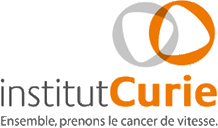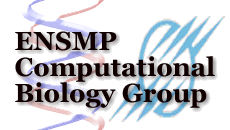Participants
- Emmanuel Barillot (PI, Institut Curie)
- Jean-Philippe Vert (co-PI, Ecole des Mines de Paris)
- Franck Rapaport (PhD student, Ecole des Mines de Paris and
Institut Curie)
- Andrei Zinovyev (Institut Curie)
- Patrick Poullet (Institut Curie)
- Philippe La Rosa (Institut Curie)
- François Radvanyi (UMR144, CNRS/Institut Curie)
- Marie Dutreix (UMR 2027, CNRS/Institut Curie)
- Olivier Delattre (UMR 509, INSERM/Institut Curie)
Presentation
The main goal of this project is to develop new methods in order to
study various types of tumors by integrating expression and genome
microarrays and prior knowledge of various regulatory networks known to
be altered in cancer. The analysis is expected to provide new
understandings of the molecular biology of tumorigenesis and tumoral
progression, as well as new tools to classify tumors. Specifically, our
goal is to detect new regulation pathways involved in several types of
cancer.
Our approach will be built on the innovative work initiated by
Jean-Philippe Vert at the Kyoto University (Vert and Kanehisa, 2003,
2003b ; Yamanishi et al, 2003, 2004), which is based on definite
positive kernel theory (Berg et al., 1984) and Hilbertian
statistical learning (Vapnik, 1998 ; Schölkopf and Smola, 2002).
This method will be extended to integrate new types of data (the genome
microarray data which informs us on the tumoral genome structure,
phenotypic variables); and to take into account the peculiarities of
regulation networks with respect to metabolic pathways (for which the
first tools were designed).
François Radvanyi (UMR144, CNRS/Institut Curie), Marie Dutreix
(UMR 2027, CNRS/Institut Curie) and Olivier Delattre (UMR 509,
INSERM/Institut Curie) will contribute to the project as expert
biologists and will be involved in experimental validation.
Results
- SHARP, a regulation pathway database has been installed at Curie
as the result of a collaboration with Ron Shamir (Tel Aviv University,
and coordinator of SHARP). It collects regulation pathways involved in
cancer. Curie biologists have it at disposal for data completion.
- The Kernel method is being adapted to the specificities of
regulation pathways.
Meeting schedule
- Group meetings took place on the 01/07/2005, 02/17/2005 (w. Pierre
Neuvial), 03/24/2005, 04/28/2005, 05/27/2005, 06/20/2005, 09/07/2005, 09/26/2005, 11/09/2005, 12/16/2005, 02/20/2006
- Next meeting scheduled on 03/20/2006
Bibliography
- J.-P. Vert and M. Kanehisa (2003), “Extracting active
pathways
from gene expression data”, Bioinformatics, 19:238-244.
- J.-P. Vert and M. Kanehisa (2003b), “Graph-driven feature
extraction from microarray data using diffusion kernels and kernel
CCA”, Advances in Neural Information Processing Systems (NIPS
15),
p.1425-1432, MIT Press, Cambridge.
- Y. Yamanishi, J.-P. Vert, A. Nakaya and M. Kanehisa (2003),
« Extraction of correlated gene clusters from mutliple genomic
data by generalized kernel canonical correlation analysis »,
Bioinformatics, 19, 323-330.
- Y. Yamanishi, J.-P. Vert and M. Kanehisa (2004), “Protein
network
inference from multiple genomic data: a supervised approach”,
Bioinformatics (in press).
- C. Berg, J. Christensen and P. Ressel (1984), “Harmonic
analysis
on semigroups”, Springer.
- B. Schölkopf and A. Smola (2002), “Learning with
kernels”,
MIT Press.
- V. Vapnik (1998), “Statistical learning theory”,
Wiley.
Support
This project ACI-IMPBIO-2004-47 is supported by the Ministry of
Research and New Technologies





